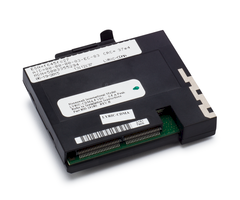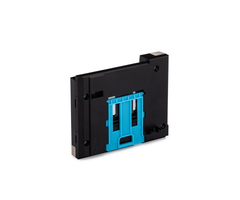How Do I Upgrade a Honeywell Lyric to Use LTE?
You can upgrade a Honeywell Lyric to use LTE by installing an LTE communicator inside the system. You'll need to buy a new communicator, make sure your Lyric has the most recent software installed, then remove the old one from the slot in the side of the Lyric, and install the new communicator into that same slot.

Once your new communicator arrives, simply follow the below procedure to upgrade from the old communicator to the new communicator. This will ensure that your system works without trouble for years to come.
- Check Your Lyric Firmware version, and update it if needed. Your Lyric System may need a firmware update before it can properly support an LTE communicator. Follow the steps in our FAQ Can I Update the Firmware On a Honeywell Lyric Alarm System? This can be done over the air (over WiFi) with little difficulty. If your panel is already on the latest firmware, nothing will happen when you press the "Update Firmware" button. If not, your firmware will update, and you can proceed to removing the old communicator and installing the new one.
- Enter cellular install mode. Put your Lyric System into its designated mode for installing a cellular communicator. To do this, start from the main screen, and choose Security > Tools > enter your Master Code > Advanced > Install Cellular Module > Yes. You can then begin installing the communicator. Remember to enter your Master Code (your main arming & disarming code), and not your Installer Code (used to enter programming).
- Install the communicator. The Lyric has a side expansion slot where you can install a cellular communicator. This slot is on the right side of the system if its screen is facing towards you. The slot can be accessed by pushing up on the cover (where the silver meets the white portion of the panel) and pulling the cover off. You will then be able to insert the communicator into the slot. Put the cover back on once you have finished. This process is explained in greater detail in this helpful FAQ.
- Enable Cellular Path. Once the LTE communicator has been physically installed, it must be enabled in panel programming. To do this, go to Security > Tools > Enter Installer Code (default is 4112) > Program > Communicator > Communication Path. Be sure any active communication path is enabled. For dual-path systems, this should be set to WIFI & Cellular. For those customers who are replacing an older cellular communicator with a new LTE module, you shouldn't need to take this step, as your communication path should already be set to include cellular.
- Activate the communicator. If this is a new cellular plan, you must now activate the communicator for monitoring service. Contact the monitoring company you are working with to get started. New Alarm Grid customers can sign up for a monitoring plan listed on our monitoring page. Make sure to have your MAC, AID and CRC codes ready for the activation. Remember to have your monitoring company test cellular signals after the activation is complete. For those who are upgrading from a 3G/4G or CDMA communicator to LTE, nothing further is required. The LTE cellular module will be activated automatically.
Cellular communication represents the most reliable communication path option available for security systems. Unlike IP connectivity, cellular service almost never goes down or becomes unavailable. And since the Lyric already has a built-in WIFI card, adding a cellular communicator will make the system dual-path ready. This will ensure fast and reliable connectivity with the Resideo AlarmNet Servers. While the Lyric can technically be used for IP-only monitoring, installing and activating a cellular communicator will ensure much better reliability for the system when communicating with AlarmNet360.
In June 2019, Resideo stopped allowing activations for 3G and CDMA communicators. As a result, any new cellular activation must use an LTE communicator. If you have a Lyric System with a 3G or CDMA communicator that is already activated, then it can continue to be used until the associated network is shut down. This is expected to occur sometime in 2022. Alarm Grid stated in a post that we will maintain support for these older communicators for as long as possible. But there is nothing we can do once the network is shut down. Also keep in mind that if you deactivate a 3G or CDMA communicator for any reason, you will not be able to reactivate it. Sooner or later, you will need to get your Lyric System on LTE, unless you plan to use it for IP only.
The reason why there is such a strong push for LTE is because of the major advantages presented from LTE networks. When compared with 3G and CDMA networks, LTE networks are much more reliable, and they offer significantly faster communication speeds. Reliability is crucial for any security system, as you want to be sure that it can send out successful transmissions during alarm events. This is the only way that you and/or a central monitoring station can be notified during a burglary, fire, or other emergency.
Also, the faster connectivity with AlarmNet360 will really come in handy when you control your system remotely through Total Connect 2.0. Lyric users have two (2) LTE communicators to choose from. There is the Honeywell LYRICLTE-A with service from the AT&T LTE Network, and there is the Honeywell LYRICLTE-V with service from the Verizon LTE Network. The communicator that you choose should depend upon the network coverage in the area where you intend on using the system. Check coverage maps, and see if the AT&T LTE Network or the Verizon LTE Network provides better coverage in your area. You might also consider getting a cellular antenna or a cellular amplifier if you find that neither network coverage is adequate in your area.
Please note that for new installations, you must activate the communicator after it has been installed in order for it to work. You will need a monitoring plan that includes cellular service. If you decide to get monitored by Alarm Grid, you will want to choose a Gold or Platinum Plan (Self or Full) or a Cell-Only Plan. Before you begin the process for installing the communicator, make sure to note the AID and CRC codes shown on the module. You should provide these codes to your monitoring company when you go to activate your monitoring service.
Did you find this answer useful?
We offer alarm monitoring as low as $10 / month
Click Here to Learn MoreRelated Products


Related Videos
Related Categories
- LTE Cellular Communicators
- LTE Cellular Communicators
- AT&T LTE Cellular Communicators
- Verizon LTE Cellular Communicators
- Answered

